As Katherine Paterson writes in “Why Historical Fiction?” “History gives us a pair of powerful eyeglasses with which to examine our own times. It is hard to look directly at our present reality because we are both too myopic and too faint-hearted.” History is alive, and historical books provide opportunities for young readers to experience times and places that, although not their own, have the potential to influence their understandings about the events of the past, the ways in which history both shaped and was shaped by individuals and groups of people, and how those people and events affect present realities. Furthermore, literature can provide multiple perspectives on history and historical events, giving voice to those whose perspectives have been excluded from other accounts. The books featured in this post demonstrate the power of children’s literature—regardless of genre and text type—both to provide information for young readers and to tell the stories of history.
Ages 4–8
Alko, Selina. (2015). The Case for Loving: The Fight for Interracial Marriage. Illus. Sean Qualls and Selina Alko. New York, NY: Arthur A. Levine.
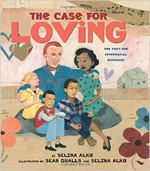 The Case for Loving conveys the story behind Loving v. Virginia, the 1967 Supreme Court case that invalidated laws prohibiting interracial marriage. After opening with (mixed-media) spreads depicting Mildred and Richard Loving and their three children at home, the narrative moves backward in time to contextualize why the couple was not allowed to marry each other in 1958 Virginia: Richard self-identified as white and Mildred self-identified as part African American and part Cherokee. Although laws in Virginia banned interracial marriages, couples like the Lovings could marry in nearby Washington, DC, which is where the couple decided to hold their marriage ceremony. Back home in Virginia, however, they were arrested and imprisoned for “unlawful cohabitation.” In order to be recognized as a married couple, the Lovings moved their family to Washington, DC. Because they wanted to live in Virginia, however, they hired attorneys who eventually argued the case before the U.S. Supreme Court, which decided unanimously in favor of the Lovings. Alko, a white Jewish woman from Canada, is married to illustrator Qualls, an African American man from New Jersey, and indicates in a note at the end of the text that her motivation to tell this story stems from her family’s own personal histories, her desire to help today’s children understand different times in U.S. history, and also from the couple’s hope “that there will soon come a time when all people who love each other have the same rights as Sean and I have.” The Loving v. Virginia case has been cited as precedence for arguments for same-sex marriage, further demonstrating how history shapes and informs what happens in the world today. Text features include notes from the author and notes about the art, a list of sources, and suggestions for further reading.
The Case for Loving conveys the story behind Loving v. Virginia, the 1967 Supreme Court case that invalidated laws prohibiting interracial marriage. After opening with (mixed-media) spreads depicting Mildred and Richard Loving and their three children at home, the narrative moves backward in time to contextualize why the couple was not allowed to marry each other in 1958 Virginia: Richard self-identified as white and Mildred self-identified as part African American and part Cherokee. Although laws in Virginia banned interracial marriages, couples like the Lovings could marry in nearby Washington, DC, which is where the couple decided to hold their marriage ceremony. Back home in Virginia, however, they were arrested and imprisoned for “unlawful cohabitation.” In order to be recognized as a married couple, the Lovings moved their family to Washington, DC. Because they wanted to live in Virginia, however, they hired attorneys who eventually argued the case before the U.S. Supreme Court, which decided unanimously in favor of the Lovings. Alko, a white Jewish woman from Canada, is married to illustrator Qualls, an African American man from New Jersey, and indicates in a note at the end of the text that her motivation to tell this story stems from her family’s own personal histories, her desire to help today’s children understand different times in U.S. history, and also from the couple’s hope “that there will soon come a time when all people who love each other have the same rights as Sean and I have.” The Loving v. Virginia case has been cited as precedence for arguments for same-sex marriage, further demonstrating how history shapes and informs what happens in the world today. Text features include notes from the author and notes about the art, a list of sources, and suggestions for further reading.
—TC
Ringgold, Faith. (2015). Harlem Renaissance Party. Illus. Faith Ringgold. New York, NY: Amistad.
 The latest from Faith Ringgold, Harlem Renaissance Party features the acclaimed artist’s signature naïve style of illustration, created in acrylics on canvas paper. It also features two characters from her previous book, Dinner at Aunt Connie’s House (Hyperion, 1993): Uncle Bates and his adopted son, Lonnie (Aunt Connie is also mentioned in passing). As the narrative opens, Lonnie and Uncle Bates view an invitation to celebrate the women and men of the Harlem Renaissance written across the sky. They catch a plane and travel back in time to “see musicians, poets, novelists, painters, activists, philosophers, and scholars: wise men and women, giants standing tall above the crowd, sharing dreams of a better life for all black people.” Upon arriving in Harlem, Lonnie and Uncle Bates visit several notable places associated with the Harlem Renaissance and African American history and culture more generally, including 7th Avenue (Adam Clayton Powell Jr. Blvd.), Well’s Restaurant, the publishing headquarters for the National Association for the Advancement of Colored People’s The Crisis magazine, one of Madam C.J. Walker’s beauty schools, the Harlem Opera House, the Schomburg Library, and the Savoy Ballroom. Along the way, the duo interacts with figures such as Jack Johnson, Marcus Garvey, W.E.B. Du Bois, Paul Robeson, Florence Mills, Zora Neale Hurston, and Langston Hughes, Lonnie’s favorite poet. On the plane home, Lonnie tells Uncle Bates that he now understands why the Harlem Renaissance is so important. “Black people didn’t come to America to be free. We fought for our freedom by creating art, music, literature, and dance.” Text features include a Harlem Renaissance Glossary and a list of books suggested for further reading.
The latest from Faith Ringgold, Harlem Renaissance Party features the acclaimed artist’s signature naïve style of illustration, created in acrylics on canvas paper. It also features two characters from her previous book, Dinner at Aunt Connie’s House (Hyperion, 1993): Uncle Bates and his adopted son, Lonnie (Aunt Connie is also mentioned in passing). As the narrative opens, Lonnie and Uncle Bates view an invitation to celebrate the women and men of the Harlem Renaissance written across the sky. They catch a plane and travel back in time to “see musicians, poets, novelists, painters, activists, philosophers, and scholars: wise men and women, giants standing tall above the crowd, sharing dreams of a better life for all black people.” Upon arriving in Harlem, Lonnie and Uncle Bates visit several notable places associated with the Harlem Renaissance and African American history and culture more generally, including 7th Avenue (Adam Clayton Powell Jr. Blvd.), Well’s Restaurant, the publishing headquarters for the National Association for the Advancement of Colored People’s The Crisis magazine, one of Madam C.J. Walker’s beauty schools, the Harlem Opera House, the Schomburg Library, and the Savoy Ballroom. Along the way, the duo interacts with figures such as Jack Johnson, Marcus Garvey, W.E.B. Du Bois, Paul Robeson, Florence Mills, Zora Neale Hurston, and Langston Hughes, Lonnie’s favorite poet. On the plane home, Lonnie tells Uncle Bates that he now understands why the Harlem Renaissance is so important. “Black people didn’t come to America to be free. We fought for our freedom by creating art, music, literature, and dance.” Text features include a Harlem Renaissance Glossary and a list of books suggested for further reading.
—TC
Weatherford, Carole Boston. (2015). Gordon Parks: How the Photographer Captured Black and White America. Illus. Jamey Christoph. Chicago, IL: Albert Whitman.
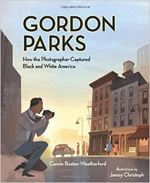 Stillborn, photographer Gordon Parks was named after the doctor who delivered him and brought him back to life by dipping him into ice water. At 14, his mother passed away and he moved to Minneapolis to live with his aunt, his mother’s sister. He held many jobs, including a porter and a waiter—positions one of his white teachers dictated to her all-black students were the only two jobs appropriate for African American people. At 25, Gordon was inspired to purchase a camera, and he began working as a photographer, moving to Chicago at the suggestion of one of the models he photographed and working as a government photographer. Noting the segregation between blacks and whites and the poverty of many African Americans, he “vows to lay bare racism with his lens.” His boss points him toward a subject for his photographs: Ella Watson, a cleaning person in the building in which Parks works. Gordon takes her picture in front of the American flag while she holds a broom, one of the tools of her trade. This fast-paced biography for young readers demonstrates the importance of photography and its significance as a form of art while bringing attention to the first African American person who wrote and directed a Hollywood film. Gordon also wrote novels and composed music and poetry, but he is famous mostly for his work as a photographer.
Stillborn, photographer Gordon Parks was named after the doctor who delivered him and brought him back to life by dipping him into ice water. At 14, his mother passed away and he moved to Minneapolis to live with his aunt, his mother’s sister. He held many jobs, including a porter and a waiter—positions one of his white teachers dictated to her all-black students were the only two jobs appropriate for African American people. At 25, Gordon was inspired to purchase a camera, and he began working as a photographer, moving to Chicago at the suggestion of one of the models he photographed and working as a government photographer. Noting the segregation between blacks and whites and the poverty of many African Americans, he “vows to lay bare racism with his lens.” His boss points him toward a subject for his photographs: Ella Watson, a cleaning person in the building in which Parks works. Gordon takes her picture in front of the American flag while she holds a broom, one of the tools of her trade. This fast-paced biography for young readers demonstrates the importance of photography and its significance as a form of art while bringing attention to the first African American person who wrote and directed a Hollywood film. Gordon also wrote novels and composed music and poetry, but he is famous mostly for his work as a photographer.
—MG
Ages 9–11
Lại, Thanhhà. (2015). Listen, Slowly. New York, NY: HarperCollins.
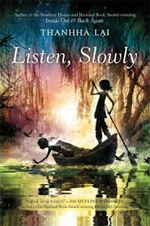 As the novel opens, 12-year-old Mai Le is in an airplane, frustrated and unhappy that her parents forced her to forego her plans for a relaxing summer with her friends in Laguna Beach, CA—the summer she has been waiting for her entire life. Despite having worked hard and excelling in school (she carries a 4.0 GPA, has an “SAT-ish” vocabulary, and is a team leader in track, science, and chess), she is told that instead of relaxing on the beach with friends, she will spend six weeks escorting her grandmother to Vietnam. Having received a letter that indicated her husband may or may not still be alive, Mai’s grandmother is determined to return to Vietnam and uncover whether her husband, a man who went missing in action during the Vietnam War and had since been presumed dead, is still living. As Mai acclimates to the small village in Vietnam in which she and her family stays (where even Internet access is limited), she begins to make friends, deepen her bond with her grandmother, and recognize how she is connected to the homeland of her parents and their family before them. The believable voice of Lại’s snarky but endearing narrator will draw readers into the novel from its opening page, and the story remains compelling throughout, underscoring the longstanding, often unanticipated effects that events can have across continents and generations.
As the novel opens, 12-year-old Mai Le is in an airplane, frustrated and unhappy that her parents forced her to forego her plans for a relaxing summer with her friends in Laguna Beach, CA—the summer she has been waiting for her entire life. Despite having worked hard and excelling in school (she carries a 4.0 GPA, has an “SAT-ish” vocabulary, and is a team leader in track, science, and chess), she is told that instead of relaxing on the beach with friends, she will spend six weeks escorting her grandmother to Vietnam. Having received a letter that indicated her husband may or may not still be alive, Mai’s grandmother is determined to return to Vietnam and uncover whether her husband, a man who went missing in action during the Vietnam War and had since been presumed dead, is still living. As Mai acclimates to the small village in Vietnam in which she and her family stays (where even Internet access is limited), she begins to make friends, deepen her bond with her grandmother, and recognize how she is connected to the homeland of her parents and their family before them. The believable voice of Lại’s snarky but endearing narrator will draw readers into the novel from its opening page, and the story remains compelling throughout, underscoring the longstanding, often unanticipated effects that events can have across continents and generations.
—TC
Ages 12–14
Almond, David, John Boyne, Tracy Chevalier, et al. (2015). The Great War: Stories Inspired by Items From the First World War. Illus. Jim Kay. New York, NY: Candlewick.
 This anthology focuses on 11 items chosen by various children’s authors as the lenses through which they write stories intended to illustrate for readers the importance and significance of the First World War. The writers of the short stories in this collection use different styles, forms, and genres, including poetry. The stories will prompt readers to question the impact and damage—not only physical—that can result from war, and encourage them to consider whether anyone benefits from it. One story mentions the role of women during the war, others seek to provide information from either the British and German sides, providing multiple perspectives for readers to consider. Ultimately, all of the stories included here share the perspective that whether one is deemed the victor is meaningless, as there are no real winners in war and violent conflicts.
This anthology focuses on 11 items chosen by various children’s authors as the lenses through which they write stories intended to illustrate for readers the importance and significance of the First World War. The writers of the short stories in this collection use different styles, forms, and genres, including poetry. The stories will prompt readers to question the impact and damage—not only physical—that can result from war, and encourage them to consider whether anyone benefits from it. One story mentions the role of women during the war, others seek to provide information from either the British and German sides, providing multiple perspectives for readers to consider. Ultimately, all of the stories included here share the perspective that whether one is deemed the victor is meaningless, as there are no real winners in war and violent conflicts.
—TC
Frydenborg, Kay. (2015). Chocolate: Sweet Science & Dark Secrets of the World’s Favorite Treat. New York, NY: Houghton Mifflin.
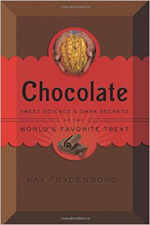 This text explores the role and importance of cacao seeds, cocoa beans, and chocolate across history and across the globe, beginning with speculations about the origin of the cacao tree between 8000 B.C. and 2000 B.C. and tracing its various ceremonial, medicinal, and culinary uses, as well as its socio-economic, political, and scientific impact, through the present day. Frydenborg weaves together an engaging narrative, investigating and analyzing the production of chocolate, its historical and contemporary ties to slave labor and human trafficking, its chemical structure and affect on humans, and its role in colonialism and industrialization. The content of the book ranges from light-hearted to horrifying and provides a complex introduction to understanding cacao and chocolate across time and cultures. Several chapters conclude with a chocolate-related recipe, including those for Aztec chocolate (1556), chocolate custards (1854), Ecuadorian hot chocolate, and Toll House chocolate crunch cookies (1936). In addition to black-and-white photographs and artwork, the book features a 16-page insert of color images. Other text features include a timeline, bibliography, list of websites, and index.
This text explores the role and importance of cacao seeds, cocoa beans, and chocolate across history and across the globe, beginning with speculations about the origin of the cacao tree between 8000 B.C. and 2000 B.C. and tracing its various ceremonial, medicinal, and culinary uses, as well as its socio-economic, political, and scientific impact, through the present day. Frydenborg weaves together an engaging narrative, investigating and analyzing the production of chocolate, its historical and contemporary ties to slave labor and human trafficking, its chemical structure and affect on humans, and its role in colonialism and industrialization. The content of the book ranges from light-hearted to horrifying and provides a complex introduction to understanding cacao and chocolate across time and cultures. Several chapters conclude with a chocolate-related recipe, including those for Aztec chocolate (1556), chocolate custards (1854), Ecuadorian hot chocolate, and Toll House chocolate crunch cookies (1936). In addition to black-and-white photographs and artwork, the book features a 16-page insert of color images. Other text features include a timeline, bibliography, list of websites, and index.
—MG
Ages 15+
Rauch, Georg. (2015). Unlikely Warrior: A Jewish Soldier in Hitler’s Army. New York, NY: Farrar Straus Giroux.
 In 1984, artist Georg Rauch reread letters he had written to his mother while he was enlisted as a telegraph operator in Hitler’s army 40 years earlier. As his wife, Phyllis, in the foreword to the memoir, says that after reading those letters, Rauch “left his art studio (a rare event) and began to write. He wrote seven days a week.” Each evening, the couple would sit together and Georg would read what he wrote; the next day, Phyllis would translate that writing into English. In 2006, 22 years after writing the manuscript and only four months before Georg passed away, the couple self-published the book, which is now revised and published for a young adult audience as Unlikely Warrior. Divided into three parts, Part One describes the military training Rauch received after he was drafted, at 19, into the German army—despite declaring that his maternal grandmother was Jewish, making him Mischlinge (the derogatory word used to describe someone who was a quarter Jewish). During the war, he worked as a telegraph and radio operator before being captured and held as a Prisoner of War in Russia. Part Two focuses on Rauch’s harrowing experiences in Russian labor camps, and Part Three describes his journey home to Vienna, where he hoped to reunite with family members. The book alternates between Rauch’s recollections and excerpts from his letters (printed in a different font). Text features include illustrations (maps, photographs, and drawings), a timeline of events, author’s note, glossaries of German and Russian/Ukrainian words, and a note about the translator.
In 1984, artist Georg Rauch reread letters he had written to his mother while he was enlisted as a telegraph operator in Hitler’s army 40 years earlier. As his wife, Phyllis, in the foreword to the memoir, says that after reading those letters, Rauch “left his art studio (a rare event) and began to write. He wrote seven days a week.” Each evening, the couple would sit together and Georg would read what he wrote; the next day, Phyllis would translate that writing into English. In 2006, 22 years after writing the manuscript and only four months before Georg passed away, the couple self-published the book, which is now revised and published for a young adult audience as Unlikely Warrior. Divided into three parts, Part One describes the military training Rauch received after he was drafted, at 19, into the German army—despite declaring that his maternal grandmother was Jewish, making him Mischlinge (the derogatory word used to describe someone who was a quarter Jewish). During the war, he worked as a telegraph and radio operator before being captured and held as a Prisoner of War in Russia. Part Two focuses on Rauch’s harrowing experiences in Russian labor camps, and Part Three describes his journey home to Vienna, where he hoped to reunite with family members. The book alternates between Rauch’s recollections and excerpts from his letters (printed in a different font). Text features include illustrations (maps, photographs, and drawings), a timeline of events, author’s note, glossaries of German and Russian/Ukrainian words, and a note about the translator.
—TC
Wein, Elizabeth. (2015). Black Dove, White Raven. New York, NY: Hyperion.
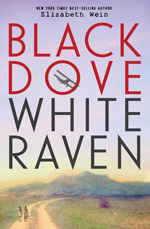 Set in the 1920s and 1930s, Elizabeth Wein’s latest novel centers on Em and Teo, two friends (more like siblings) whose mothers performed together as barnstormers, “Black Dove” and “White Raven.” When the plane the two aviators are flying strikes a bird and crashes, Teo’s mother, Delia, is killed. Em’s mother, Rhoda, decides to relocate the surviving trio to Ethiopia, where Delia had already planned to move with her son before her untimely death. Delia’s desire to move her family was grounded in the fact that Teo’s father was from Ethiopia, but also rooted in her hope that there, Teo would not be discriminated against because of the color of his skin. Rhoda’s decision to relocate the family is made, in part, to honor Delia’s wishes, but also results from her own hope that Ethiopia will be a place in which Em would not face discrimination as a result of her gender. The family’s new life on a coffee plantation is interrupted by geopolitical events, as Mussolini’s troops prepare for their invasion of Ethiopia. The richly written, descriptive narrative moves slowly for the first two-thirds of the novel, before building and springing into action in the final act. Told through alternating voices and formats (such as stories, letters, school essays, and flight log entries), the novel is as much about the power and strength of friendship and family as it is about the 1935 Italian invasion of Ethiopia. An author’s note at the end of the text provides contextual information about the novel and its characters and also describes and clarifies how Wein attempted to balance historical fact and storytelling.
Set in the 1920s and 1930s, Elizabeth Wein’s latest novel centers on Em and Teo, two friends (more like siblings) whose mothers performed together as barnstormers, “Black Dove” and “White Raven.” When the plane the two aviators are flying strikes a bird and crashes, Teo’s mother, Delia, is killed. Em’s mother, Rhoda, decides to relocate the surviving trio to Ethiopia, where Delia had already planned to move with her son before her untimely death. Delia’s desire to move her family was grounded in the fact that Teo’s father was from Ethiopia, but also rooted in her hope that there, Teo would not be discriminated against because of the color of his skin. Rhoda’s decision to relocate the family is made, in part, to honor Delia’s wishes, but also results from her own hope that Ethiopia will be a place in which Em would not face discrimination as a result of her gender. The family’s new life on a coffee plantation is interrupted by geopolitical events, as Mussolini’s troops prepare for their invasion of Ethiopia. The richly written, descriptive narrative moves slowly for the first two-thirds of the novel, before building and springing into action in the final act. Told through alternating voices and formats (such as stories, letters, school essays, and flight log entries), the novel is as much about the power and strength of friendship and family as it is about the 1935 Italian invasion of Ethiopia. An author’s note at the end of the text provides contextual information about the novel and its characters and also describes and clarifies how Wein attempted to balance historical fact and storytelling.
—TC
Thomas Crisp is an assistant professor in the Department of Early Childhood and Elementary Education, where he teaches courses in children’s and young adult literature and literacy. Mehmet Gultekin is currently a PhD student in the Department of Early Childhood and Elementary Education, where he also works as a research assistant. They are both at Georgia State University.
The review contributions are provided by members of the International Literacy Association’s Children’s Literature and Reading Special Interest Group.